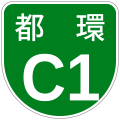The Inner Circular Route (都心環状線, Toshin Kanjō-sen), signed as Route C1, is one of the routes of the Shuto Expressway system serving the central part of the Greater Tokyo Area. The route is a complete loop around the central Tokyo wards of Chiyoda, Chūō, and Minato, with a total length of 14.8 kilometers (9.2 mi). In addition to serving areas of central Tokyo, the Inner Circular Route also serves as the origin of the radial routes of the Shuto Expressway. A section of the expressway is built above the Shibuya River.
|
Shuto Expressway Inner Circular Route 首都高速都心環状線 | |
|---|---|
The Inner Circular Route highlighted in red | |
| Route information | |
| Part of | |
| Maintained by Metropolitan Expressway Company Limited | |
| Length | 14.8 km (9.2 mi) |
| Existed | 1962–present |
| Major junctions | |
| Beltway around Tokyo | |
| Location | |
| Country | Japan |
| Highway system | |
History
editThe expressway was built between 1962 and 1967, partly in preparation for the 1964 Summer Olympics. In 2009, Tokyo private industries proposed funding a project to dismantle the elevated expressway and put them underground.[1]
In May 2020, the Shuto Expressway Company received approval for plans to relocate 1.8 kilometers of the expressway underground between Kandabashi and Edobashi Junctions, in the area where the Nihonbashi Bridge is located.[2] Construction will commence with the permanent closure of the Edobashi and Gofukubashi entrance and exit ramps on 10 May 2021.[3][4] Construction is expected to be completed in fiscal year 2040.[4]
List of interchanges
editList of interchanges ordered clockwise beginning with Edobashi Junction. The entire expressway is in Tokyo.
| Location | km[5] | mi | Exit | Name | Destinations | Notes | |
|---|---|---|---|---|---|---|---|
| Chūō | 0.0 | 0.0 | — | Edobashi | Clockwise entrance, counterclockwise exit; distance posts reset to zero, eastern terminus of AH1 | ||
| 0.8 | 0.50 | 11 | Takarachō | Yaesu-dōri | Clockwise exit, counterclockwise entrance | ||
| 1.0 | 0.62 | — | Kyōbashi | Spur route to Tokyo Expressway | Clockwise exit, counterclockwise entrance | ||
| 1.6 | 0.99 | 12 | Kyōbashi | Kajibashi-dōri – Kyōbashi, Eitaibashi | Clockwise entrance, counterclockwise exit | ||
| 1.7– 1.9 | 1.1– 1.2 | 13/14 | Shintomichō | Tokyo Metropolitan Route 50 (Shin-Ōhashi-dōri) – Shin-Ōhashi, Tsukuda, Shiodome | Exit only | ||
| 2.0– 2.5 | 1.2– 1.6 | 15/16 | Ginza | Ginchū-dōri | |||
| 3.2 | 2.0 | 18 | Shiodome | Kaigan-dōri – Shinbashi | Clockwise entrance, counterclockwise exit | ||
| 3.4 | 2.1 | — | Shiodome | Clockwise entrance, counterclockwise exit | |||
| Minato | 4.3 | 2.7 | — | Hamazakibashi | |||
| 5.2– 5.7 | 3.2– 3.5 | 19/20 | Shiba-kōen | ||||
| 6.6 | 4.1 | — | Ichinohashi | ||||
| 7.2 | 4.5 | 21 | Iikura | Tokyo Metropolitan Route 415 (Azabu-dōri) – Roppongi | |||
| 7.8 | 4.8 | — | Tanimachi | Clockwise beginning of AH1 concurrency | |||
| Chiyoda | 8.8– 9.2 | 5.5– 5.7 | 23/24 | Kasumigaseki | Tokyo Metropolitan Route 415 (Roppongi-dōri) – Hibiya, Hanzōmon, Nagatachō | ||
| 10.2 | 6.3 | — | Miyakezaka | ||||
| 11.6 | 7.2 | 25 | Daikanchō | Uchibori-dōri – Kitanomaru Park | Clockwise exit, counterclockwise entrance | ||
| 12.0 | 7.5 | 26 | Kitanomaru | Uchibori-dōri – Hitotsubashi | Clockwise entrance, counterclockwise exit | ||
| 12.3 | 7.6 | — | Takebashi | ||||
| 12.9– 13.2 | 8.0– 8.2 | 28/29 | Kandabashi | Hibiya-dōri – Ōtemachi | |||
| 13.3 | 8.3 | — | Kandabashi | Clockwise exit, counterclockwise entrance | |||
| Chūō | 14.0 | 8.7 | 30 | Gofukubashi | Closing 10 May 2021[4] Clockwise entrance, counterclockwise exit | ||
| 14.2 | 8.8 | 31 | Edobashi | Tokyo Metropolitan Route 316 (Shōwa-dōri) | Closing 10 May 2021[4] Clockwise exit, counterclockwise entrance | ||
1.000 mi = 1.609 km; 1.000 km = 0.621 mi
| |||||||
References
edit- ^ Keisuke Okada (17 March 2012). "Push to replace Tokyo's aging expressways with tunnel routes revived". The Japan Times. p. 3. Retrieved 20 July 2020.
- ^ "首都高速道路日本橋区間の地下化事業の都市計画事業認可について" [The Gofukubashi and Edobashi ramps on the downtown loop line will be abolished at midnight on 10 May 2021 (Monday).] (Press release) (in Japanese). Shuto Expressway. 21 May 2020. Retrieved 16 March 2021.
- ^ "都心環状線 呉服橋出入口・江戸橋出入口を2021年5月10日(月)午前0時に廃止します" [The Gofukubashi and Edobashi ramps on the downtown loop line will be abolished at midnight on 10 May 2021 (Monday).] (Press release) (in Japanese). Shuto Expressway. 26 January 2021. Retrieved 16 March 2021.
- ^ a b c d "首都高、2021年5月10日に呉服橋・江戸橋出入口を廃止". news.yahoo.co.jp (in Japanese). Yahoo! News (Japan). 8 February 2021. Archived from the original on 8 February 2021. Retrieved 16 March 2021.
- ^ "Inner Circular Route" (Map). Google Maps. Retrieved 23 July 2020.

